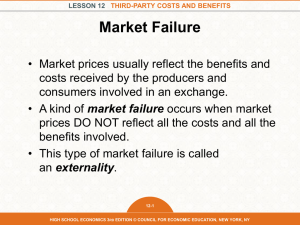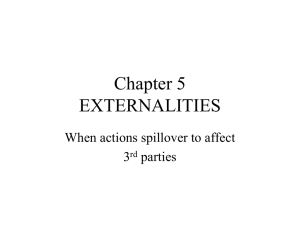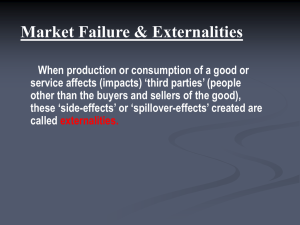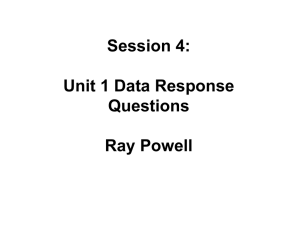Bradfield The Economic, Social and Environmental
advertisement
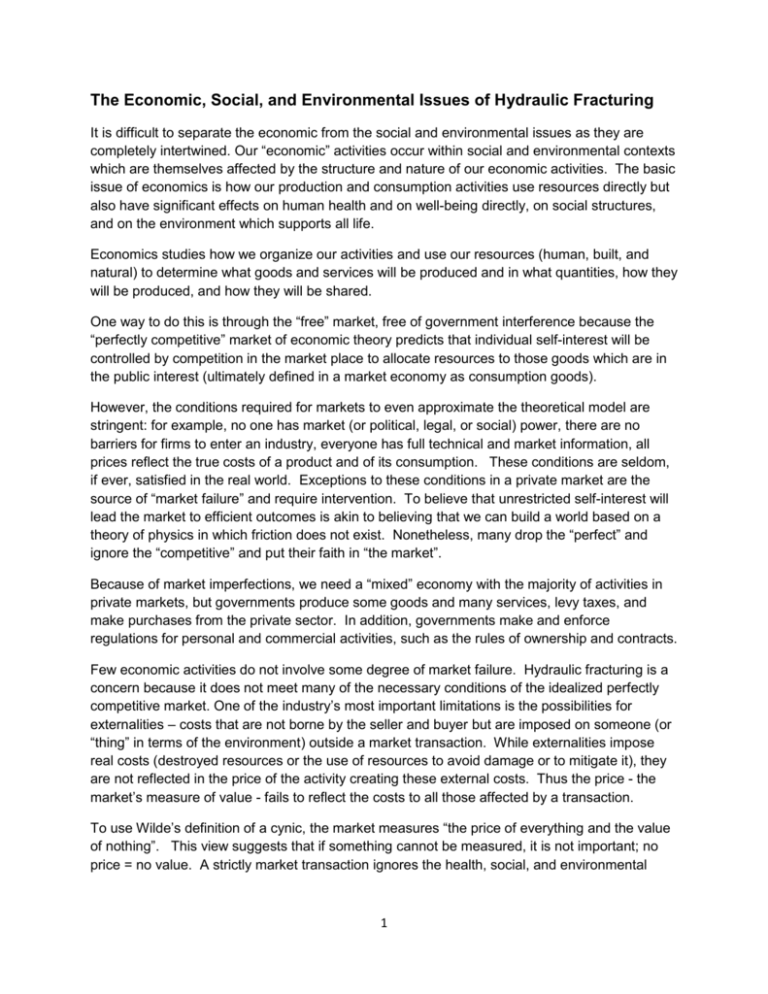
The Economic, Social, and Environmental Issues of Hydraulic Fracturing It is difficult to separate the economic from the social and environmental issues as they are completely intertwined. Our “economic” activities occur within social and environmental contexts which are themselves affected by the structure and nature of our economic activities. The basic issue of economics is how our production and consumption activities use resources directly but also have significant effects on human health and on well-being directly, on social structures, and on the environment which supports all life. Economics studies how we organize our activities and use our resources (human, built, and natural) to determine what goods and services will be produced and in what quantities, how they will be produced, and how they will be shared. One way to do this is through the “free” market, free of government interference because the “perfectly competitive” market of economic theory predicts that individual self-interest will be controlled by competition in the market place to allocate resources to those goods which are in the public interest (ultimately defined in a market economy as consumption goods). However, the conditions required for markets to even approximate the theoretical model are stringent: for example, no one has market (or political, legal, or social) power, there are no barriers for firms to enter an industry, everyone has full technical and market information, all prices reflect the true costs of a product and of its consumption. These conditions are seldom, if ever, satisfied in the real world. Exceptions to these conditions in a private market are the source of “market failure” and require intervention. To believe that unrestricted self-interest will lead the market to efficient outcomes is akin to believing that we can build a world based on a theory of physics in which friction does not exist. Nonetheless, many drop the “perfect” and ignore the “competitive” and put their faith in “the market”. Because of market imperfections, we need a “mixed” economy with the majority of activities in private markets, but governments produce some goods and many services, levy taxes, and make purchases from the private sector. In addition, governments make and enforce regulations for personal and commercial activities, such as the rules of ownership and contracts. Few economic activities do not involve some degree of market failure. Hydraulic fracturing is a concern because it does not meet many of the necessary conditions of the idealized perfectly competitive market. One of the industry’s most important limitations is the possibilities for externalities – costs that are not borne by the seller and buyer but are imposed on someone (or “thing” in terms of the environment) outside a market transaction. While externalities impose real costs (destroyed resources or the use of resources to avoid damage or to mitigate it), they are not reflected in the price of the activity creating these external costs. Thus the price - the market’s measure of value - fails to reflect the costs to all those affected by a transaction. To use Wilde’s definition of a cynic, the market measures “the price of everything and the value of nothing”. This view suggests that if something cannot be measured, it is not important; no price = no value. A strictly market transaction ignores the health, social, and environmental 1 impacts it may impose on others, even though society may put a very high value on the affected areas. Externalities When externalities exist, market prices no longer reflect the full cost of a good. As most of our economic measures are based on prices, we cannot say that something is “efficient” simply because the producer makes a profit and the consumer is satisfied with the price paid. When externalities are present, society bears additional costs which must be recognized and factored into the price for an activity to truly maximize the benefits for society. With hydraulic fracturing, there are potential externalities at each stage, from exploration to development to production to decommissioning. The costs of such externalities must be estimated to decide if this is a viable way to access an energy source. These costs vary with respect to their geographic impact, their duration, and timing, e.g., at the time of an activity or much later, perhaps long after production of unconventional gas has ceased at a given site. For instance, the development stage may affect the immediate area – blasting and the movement of trucks and equipment affect the enjoyment people have from their homes along the highway or near the well site. In addition, the more rapid deterioration of the road and other common infrastructure generate increased construction or maintenance costs. Congestion on roads may impose social (time) rather than direct financial costs on its users, but these are costs nonetheless. The operation of a well site involves bringing water and chemicals in and taking product and waste water out. This generates increased truck traffic with external costs, including safety concerns. The production stage may mean the flaring of “sour gas” which might affect the health of people and their animals, as well as of wild life, in the area. The geographic impact of the production externalities may be broader than the immediate area. The flow of ground and subsurface water may carry fracking fluids away from well sites, and methane and chemicals may eventually work their way to the surface. The impacts on people and the environment are uncertain but potentially serious and long-lasting. It is in the self-interest of both the producer and the consumer to reduce their own financial costs by generating externalities – profits increase and prices fall. Of course, both producers and consumers, because of effects on their environment and taxes, may be indirectly affected by their own externalities, but usually by only a tiny amount of the external costs they impose on others (and save for themselves). While discussion of externalities is often focused on production, some of the longest-lasting and broadest externalities of fracking are likely to occur from consumption. Even if unconventional gas has a lower carbon footprint than other energy sources, if it delays the necessary shift to renewable energy sources, it will still add to greenhouse gases and therefore to global warming. This is an externality that is largely borne outside Nova Scotia and Canada, but nonetheless must be considered in assessing the real costs of unconventional gas. We cannot justify making our economies less costly financially by imposing real costs on others. 2 Dealing with externalities There are many ways to deal with externalities - within the market, with government setting upper limits on the level of externalities or on the activities that generate them, through the regulation of those activities, or through an outright ban on those activities. Many argue that market failure due to externalities can be solved by the market itself. Some propose self-regulation by the firms involved, jointly agreeing on behaviours to avoid generating externalities in order to enhance their individual competitive position. Self-regulation has limited potential, given the incentives to set the bar low, under-report incidents, and the difficulties of enforcement for a voluntary association. In theory, the solution is for the market to “internalize the externality”, i.e., force the market transaction to include the costs of the externalities. In this scenario, government’s function is to establish the legal framework – set up auctions for pollution rights or require full legal liability to compensate those forced to bear the external costs. This is the rationale for the Nova Scotia Environment Act requiring that those who pollute must pay the costs they impose.i Faced with these additional costs, firms would choose the production method which imposes the lowest financial cost and, therefore, the most efficient technology, as the real cost of production and distribution this would now include this financial cost. Both of these market solutions have fundamental flaws. In an auction, the government establishes a maximum quantity of a particular type of pollution and auctions off the rights to generate it. The auction supposedly establishes the value to society of the external costs – the firms which save the most from being allowed to pollute will outbid the others. This financial cost will increase prices and the quantity demanded will fall, so there will be less pollution. Externalities are paid for and their level reduced. But does an auction just sell the right to pollute? The rebuttal to this is that anyone can join the auction. Those who want to avoid the externality or to lower the level of pollution to an “acceptable” level (e.g., the level at which natural systems can handle it) can put their money where their mouth is and outbid the industries who save other resources by being allowed to pollute. The problem is that the polluting firms have the information about the nature and quantity of their pollutants, they know the implications of losing the auction, and they have funds to bid. On the other hand, those affected by the externalities are usually dispersed, have limited information, and lack the organization and funding to effectively engage in the auction. They are often marginalized, for instance small farmers or First Nations people with limited funds or political influence. Moreover, they would suffer from the “free rider” problem – some people would not offer to fund a joint bid, hoping that what others do will be sufficient to protect them from the externality costs. These difficulties are lessened, but not removed, with the liability approach in which the potential polluter is required to get full liability insurance. The theory is that the insuring company will conduct due diligence and assess the probability of an event generating 3 externalities, their likely impacts and costs, and the possibility of an expensive legal battle to establish the liability and the amount. These estimated costs would then be part of the cost of the liability insurance premiums for the potential polluter. If these premiums are too high, production will not occur and the externalities will not be generated – the product is not worth its cost and the interests of society are served. But even this does not mean that the premiums will accurately reflect the probable external costs. The insurance company’s estimate is likely to be lower than the actual costs. Their estimates are discounted by the probability of a successful suit which depends on the ability of those affected by the externality to mount their case, by the rigour with which the law is applied, and by the insurance company’s lawyers’ skills. Moreover, the polluter can expense their legal costs against profits, lowering their corporate income taxes - the public pays part of the cost which the company incurs to avoid paying compensation for the damages it has caused. Thus requiring full liability for externalities has the same problems as the auction approach. The polluter knows more about its emissions than others, and has the financial self-interest to challenge anyone who might sue them. The onus of proof is on the complainants who face the information, organization, and funding problems found with auctions. In addition, the polluters may engage in a variety of tactics to confuse the public, such as funding supposedly independent think tanks to question the science around the nature and source of the externalities and initiating Strategic Lawsuits Against Public Participation (SLAPPs), legal efforts to head off legal action by those affected by pollution. Further, the government may be lobbied to relieve an industry of its liability exposure. A case in point – nuclear power. In Canada and the U.S., the nuclear electric energy industries successfully lobbied to have caps put on their liability in the event of a major nuclear accident. They argued that, if required to pay the insurance premiums for full liability, they would be priced out of the electricity market. Effectively, this was an admission that the externalities were so large, nuclear energy was not worth the risk. The cap on their liability means that they can compete only by exposing society to considerable uncompensated risks. The cap means that profits are protected, but not people nor the environment. This is not to argue that auctions or full liability have no place in the policy tool kit, but these approaches do not remove the fundamental causes of market failure. These approaches must be carefully crafted to avoid the pitfalls of the market solutions. The need for strong regulation should be obvious. Regulation – Best practice, Highest Standards, Mitigation, and Technology Often regulation and penalties for environmental and health damage are cited as taking care of the issue of externalities. Faced with stringent rules and strong enforcement, it is claimed that firms will not only be sensitive to the issue of externalities but seek to perform to the highest standards by using the best practices and the latest technologies. Moreover, we are to believe that any problems that might nonetheless occur will be dealt with by the firms’ mitigation plans. Is this sufficient? 4 How stringent are the regulatory regimes? First consider who has the most information to determine external effects and costs, the government or the industry? Normally it is the latter. Therefore it is common practice for government to hire those best informed to design the regulations – insiders from the industry1. But once they have helped design the regulations these people often leave government – for jobs back in the industry. The deregulation of the financial sector and the crisis of 2008 are a clear example of this. Moreover, many government regulators eventually retire and also join the industry. This revolving door between regulated industries and the agencies which police them clearly raises concern about how stringent the regulations are and how vigorously they are enforced. This concern is heightened when the public sees malleable politicians2 who adhere to the free market mythology and instruct enforcement agencies accordingly. Moreover, regulators trying to enforce the rules often rely on the regulated firms for information. It is instructive that the current debate about transporting gas and oil has led to disclosures that pipeline and rail companies have not fulfilled their obligations to report leaks or accidents.3 Another issue respecting the effectiveness of regulation and forms of control is that external costs often take a long time to be recognized but corporations have a very short profit horizon and politicians a short political horizon. These limited horizons fit nicely with short-term benefits of activities that need to be regulated. Nova Scotians are keenly aware of these difficulties from experiences such as the Westray4 mine disaster and the collapse of the cod stocks5. In the case of hydraulic fracturing, the possible migration of fracking fluids into wells or aquifers could take decades. How much comfort can we take in “best practice” and “highest standards”? These are normally the goals of regulation but they do not guarantee that externalities will be eliminated or fully compensated for. In addition, they may only mean that producers will meet the standards if they do not cost too much and the penalties for ignoring the regulations are high. Moreover, relying on evolving technologies to eventually deal with the issues is an admission that existing practices are generating externalities; production should wait until adequate technologies are available and thoroughly tested. Again, the nuclear power industry is instructive, as no satisfactory method of disposal of their radioactive waste has yet been found. Similarly, the promise of mitigation is no more than a promise to try to avoid or to undo or make up for externalities. Mitigation lessens the impact but does not remove it. As some of the 1 For instance Alberta’s Premier Redford, appointed Gerard Protti, a founder of the Canadian Association of Petroleum Producers, as chief of Alberta's new energy regulator. 2 For instance, a federal Minister of the Environment called environmentalists “terrorists” for questioning the expansion of the tarsands. 3 Moreover, it has been reported that the railway association had, prior to the tragedy of Lac Megantic, lobbied for a change in the regulations to require fewer and less intensive inspection of trains safety procedures and equipment 4 In the Westray case, the coal company ignored safety regulations and tampered with safety monitors. 5 The politicians ignored the advice of biologists and inshore fishermen and approved unsustainable quotas for the trawler fleet. 5 externalities will involve health, social, and environmental impacts that cannot be reversed, mitigation is not a guarantee that externalities will be fully accounted for. Other costs and concerns Related to the issue of externalities is the question of the use of the de-commissioned well-sites. Can the sites be returned to their original use or converted to new uses or do the abandoned wells make the sites unsuitable for other uses even if the company follows through with its remediation plans? There is also the question of infrastructure – will the company build and maintain all infrastructure specific to its needs? Will it pay the taxes to build and repair roads and other public infrastructure that it will strain by its additional use? Where will the company get the large amounts of water required and how will this diversion of water affect its current environmental and other uses. What will the company do with the waste water? And what is the net impact of a project on other taxpayers? Companies often cite the taxes they will add to provincial or local coffers, but ignore the ”tax expenditures” – the tax revenues lost by giving potential employers tax concessions – and the direct cash subsidies often expected. Is this an industry where such special treatment is expected, even demanded? In addition there is the question of royalties and corporate taxes – does the provincial government simply apply a fixed percentage of the federal profit tax or does it have its own corporate tax form as it does for personal income tax? What royalty regime applies? Can the provincial government apply its own set of tax rules or other rules, for instance banning SLAPPs (as Quebec has done) or legislating that a company cannot deduct from its profits the legal fees to finance a SLAPP or the cost of advertising to sway the public? There are also questions of the rights of ownership. With most commodities, private ownership means 100% control of an asset. However, in Nova Scotia, the Province claims subsurface rights. This is even more complicated with horizontal drilling. If a community (e.g., Sackville) imposes a ban on fracking, does this prevent a company from setting up on its boundaries and fracking underneath? How easy is it for a firm to expropriate land from owners who place a value on their land which is above the going market price? Do trade agreements, such as the NAFTA and the CETA, give a company the right to sue a government for lost profits if, because of health or environmental issues, a government passes legislation which restricts fracking? There are other sources of market failure in dealing with the energy issue. In perfectly competitive markets, all actors are presumed to have full information to assess a transaction – for instance, municipalities need to know what is in the waste water and how it can be treated. However, not all jurisdictions get full information. Market failure also occurs when transactions are made between agents with unequal power in the market place – what bargaining power is held by small towns and even small provinces and by workers, compared to the companies with which they deal? Not everyone has viable alternatives, even if legally treated as equals. “The law treats rich and poor alike; both are prohibited from sleeping under bridges…” (Anatole France) 6 Benefits of unconventional gas Of course, to assess any project, we must weigh its benefits against its cost. In a “free market”, this is the private calculus in which there is deemed to be a net benefit to society if the producer can sell its product at a price which covers all the financial costs and leaves a profit. As there are significant concerns about the externalities involved, this market “test” is not adequate for hydraulic fracturing. The primary benefit of hydraulic fracturing is that it gives access to a new source of energy, to unconventional energy. As Nova Scotia is heavily dependent on imported energy, some with a high carbon footprint, at the right cost unconventional gas may be an important6 alternative source of energy. Without detailed evidence of its potential and real costs, the viability of unconventional gas in Nova Scotia is not yet determined. If it is desirable to extract significant amounts of unconventional gas, will Nova Scotians have access to it? Will the size and location of the gas deposits justify an internal distribution system or will the bulk of the supply be exported? Will the gas be distributed by truck or pipeline and which is safer? If the gas is exported, the energy advantage of the sector would be that the export dollars could be used to import other sources of energy whose price and sustainability are better than our own energy supplies. This depends on the amount of the export revenue which stays in Nova Scotia. This, in turn, depends on the capital intensity of the industry (revenue/capital costs), the wages and the lease rentals paid to Nova Scotians for the placement of wellpads and pipelines, and the extent to which the industry is owned within Nova Scotia, and the royalty revenues. In the best-case scenario, the industry would be locally owned, perhaps by municipal utilities, employing local workers (men and women) who have the necessary skills when needed. Their average wages would be above current levels (and above the median wage even more so, for development of the industry to reduce the rate at which income disparities are increasing). Much of the physical capital requirements would also be met locally, increasing the possibility of developing a long-term capital-goods industry. Similarly, the financial capital for the industry would be from local investors so that both dividends and control remain in Nova Scotia. The best-case scenario would include other spin-offs to the local economy, such as supplying the input needs of the industry and engaging in research on the production technology and alternative uses for this technology and the gas itself. Of course, the best-case scenario assumes that the unconventional gas reserves would be viable for at least a generation, so that the capital, worker, and infrastructure investments can be fully paid for within the life-time of the sector. To achieve the necessary conditions for the best-case, the sector should develop slowly, allowing local interests to adjust to its demands and expectations. Slow growth lengthens the duration of the sector, allowing a more cautious approach to dealing with the externalities. In 6 but perhaps relatively short-term alternative as greener energy technologies are developed and become competitive 7 some cases, as in Germany, their stringent environmental laws led to “green” industries which serve local needs and developed an expertise which generates exports of both green products and green consulting. Note, however, that the exports are not the goal; meeting local needs is the goal. The export spin-offs are an indication of the success in meeting local needs and the competitive edge this gives German firms. Of course, we cannot expect the industry to generate the best case scenario. Nonetheless, it provides a benchmark against which to assess the benefits the industry may generate, Conclusions Given the number, complexity, and uncertainty of the externalities and other issues involved in hydraulic fracturing, if or when fracking is permitted, the appropriate regulation will be complex, difficult, and costly because it must be executed rigorously and with the highest professional standards. The cost should be borne by the industry so that its private calculus reflects all of the social costs incurred. The issues raised here indicate the many areas where more information is necessary to come to grips with the large and long-lasting impacts of hydraulic fracturing. These are addressed in the chapters that follow. ___________________________ The Economic, Social, and Environmental Issues of Hydraulic Fracturing was written by Dr. Michael Bradfield, panel member of the Independent Review of Hydraulic Fracturing, to provide an economic analysis chapter for the Review report. As much of this material did not appear in the Panel’s final report, Dr. Bradfield has agreed to make his original material available to the public through this website. May 2014 i East Coast Environmental Law, “Failure to Enforce? Time for transparent and effective environmental enforcement in Nova Scotia” (June 2014) Online at http://www.ecelaw.ca/92-failure-to-enforce-final-june2014.html 8


